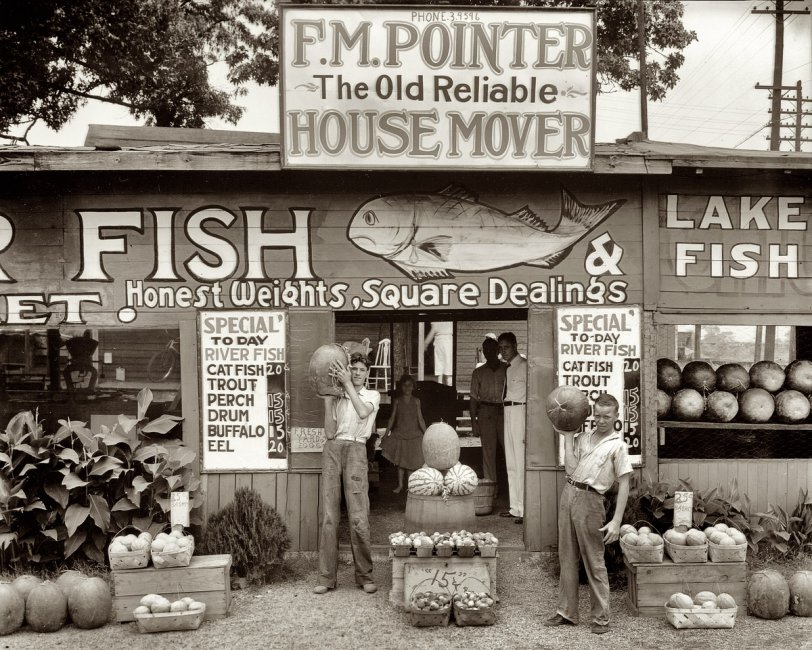


Framed or unframed, desk size to sofa size, printed by us in Arizona and Alabama since 2007. Explore now.
Shorpy is funded by you. Patreon contributors get an ad-free experience.
Learn more.

- Uncle SAAM
- Obfuscation
- One Chocolate Soldier rode away
- Victor Marquis de la Roche
- The Little House Across Way ...
- Vanderbilt Gates
- Vanderbilt Mansion
- You can still see that gate
- Withering heights for me
- So Jim,
- Top Heavy
- Re: Can't Place It.
- Bus ID
- Since you mention it
- The White Pages ?
- Moonlight Tower
- 1907?
- Fire(men) and Water
- Can't Place It
- Can anyone
- Wings
- Where's Claudette and Clark?
- Overbuilt Rolodex
- One song
- Give Me Wings Please!
- PRR
- Pinball Wizards
- Possible anti-dancing rationale
- Life imitates art
- Don't dance to the Packard!
Printporium
Catfish Mover Watermelon: 1936

Summer 1936. Roadside stand near Birmingham, Alabama. View full size. Medium-format negative by Walker Evans for the Farm Security Administration.
Olive Oyl
When I was a kid in the early 1940s we used to call up a store and ask if they had olive oil in a can, and when they said yes we would say better let her out, Popeye is looking for her, and then we would laugh like crazy.
Hello Central
When the numbers were that short, they probably went through an operator. Our telephone number was 200 but you told the operator you wanted Commerce (the town) 200. We didn't have dial telephones back then (even rotary).
No redial either
I recall back then we had rotary phones, no contact list and not even redial. Every extra number could become a real pain to the index finger. Of course, that's if the line was free and there wasn't another party on the line. I still remember when I was caught listening to the telephone when I was very young. I had no idea why my mother would get so upset. In my neighborhood a private line was very rare.
Phone Numbers
My family in central Nebraska used 5 digit direct dialing until the late 1990s. What happened? The internet - they now have to dial 10 numbers whether it's local or long distance. On the plus side, they have one of the last private phone companies, and even though my parents live 7 miles out in the country, they could have dsl if they wanted it, because their phone company ran fiber optic lines to [i]all[/] of their customers.
I'm half a mile from a Verizon "office" (it's actually more of a switching station), and I can't get DSL. Yeah, I know that legally they should be providing it, but "who ya gonna call?" It's a huge corporation - "your call is very important to us..., but we are experiencing high call volume..."
Five-digit phone numbers
I don't know how things worked in Birmingham, or in Bar Harbor, but in my home town in Indiana, the way it worked was, we had seven-digit phone numbers, but if the number you were calling was in the same exchange as yours, you only dialed the last five digits.
So if your phone number was KLaxon 5-3270 (555-3270), and someone was calling you from another KLaxon phone number, they would dial 53270. If someone was calling you from the CHerry exchange, they would dial 5553270. Exchanges were kind of like area codes, only for smaller areas. (Area codes went into effect in 1947. I just looked that up.)
By the time I came along, pretty much every business would display the full seven-digit number, as either the exchange name and five numerals, e.g., KLaxon 5-3270, or two letters and five numerals, e.g., KL5-3270. I don't remember ever seeing just the last five numerals.
I remember when the switch was made in the mid-60s (where I lived, at least) to seven-digit dialing for all phone numbers, but I was too young to know if people found it to be a big wrench to the system. Some businesses still referred to their phone number as "TUxedo 4 -xxxx" or "YEllowstone 8 - xxxx" or whatever well into the 70s.
[In 1947 the North American Numbering Plan laid the groundwork for direct dialing of long distance calls. The first area codes came into use in 1951, but it would be many years before direct dialing and area codes really took hold. - Dave]
Phone numbers
As late as 1979, in Sonoma, California, if you were calling in town you only needed to call the last four numbers, everyone had the same prefix.
3-9596
Is that the entire phone number on the top of the sign? I'm guessing that there were not many phones in use back then and therefore we had not reached the need for 10 digit numbers. Amazing.
Justin
Houston, TX
[Below: Example of a three-digit phone number from the 1950s - Dave]

























On Shorpy:
Today’s Top 5